I'm looking to run this code that enables to solve for the unknowns c_10 and c_01 from just plotting the graph.
Some background on the equation is using Mooney-Rivlin model (1940) with c_10[(2*λ+λ**2)-3]+c_01[(λ**-2+2*λ)-3].
Some of the unknowns I_1 and I_2 are defined below in the code. P1 (or known as P) and lambda are data pre-defined in numerical terms in the table below (sheet ExperimentData of experimental_data1.xlsx):
λ P
1.00 0.00
1.01 0.03
1.12 0.14
1.24 0.23
1.39 0.32
1.61 0.41
1.89 0.50
2.17 0.58
2.42 0.67
3.01 0.85
3.58 1.04
4.03 1.21
4.76 1.58
5.36 1.94
5.76 2.29
6.16 2.67
6.40 3.02
6.62 3.39
6.87 3.75
7.05 4.12
7.16 4.47
7.27 4.85
7.43 5.21
7.50 5.57
7.61 6.30
Below is the code:
import numpy as np
import matplotlib.pyplot as plt
from scipy.optimize import curve_fit
import warnings
from scipy.optimize import differential_evolution
# Generic Mooney-Rivlin Equation
# bounds on parameters are set in
# generate_Initial_Parameters() below
def generic_equation(c_10, c_01, λ, P):
P = c_10[(2 * λ + λ ** 2) - 3] + c_01[(λ ** -2 + 2 * λ) - 3]
return (P)
# function for genetic algorithm to minimize (sum of squared error)
# bounds on parameters are set in generate_Initial_Parameters() below
def sumOfSquaredError(parameterTuple):
warnings.filterwarnings("ignore") # do not print warnings by genetic algorithm
return np.sum((yData - generic_equation(xData, *parameterTuple)) ** 2)
def generate_Initial_Parameters():
# min and max used for bounds
maxX = max(xData)
minX = min(xData)
maxY = max(yData)
minY = min(yData)
parameterBounds = []
parameterBounds.append([0.0, 1.0*1000000.0]) # parameter bounds for c_10
parameterBounds.append([0.0, 1.0*1000000.0]) # parameter bounds for c_01
parameterBounds.append([minX, maxX]) # parameter bounds for λ
parameterBounds.append([minY, maxY]) # parameter bounds for P
# "seed" the numpy random number generator for repeatable results
result = differential_evolution(sumOfSquaredError, parameterBounds, seed=3)
return result.x
# load the test data from Experimental dataset
data = pd.read_excel('experimental_data1.xlsx', sheet_name='ExperimentData')
xData = data['λ'].values
yData = data['P'].values
# generate initial parameter values
initialParameters = generate_Initial_Parameters()
# curve fit the test data
fittedParameters, pcov = curve_fit(generic_equation, xData, yData, initialParameters)
# create values for display of fitted peak function
c_10, c_01, λ, P = fittedParameters
y_fit = generic_equation(xData, c_10, c_01, λ, P)
plt.plot(xData, yData) # plot the raw data
plt.plot(xData, y_fit) # plot the equation using the fitted parameters
plt.show()
print(fittedParameters)
When I run it, this error is produced:
RuntimeError: The map-like callable must be of the form f(func, iterable), returning a sequence of numbers the same length as 'iterable'
This is the original code found from here.
